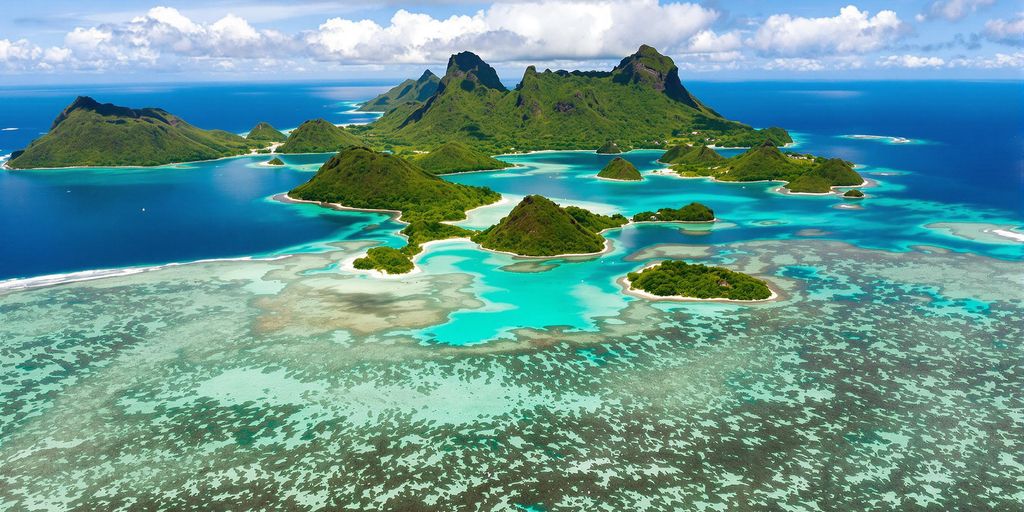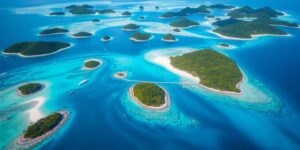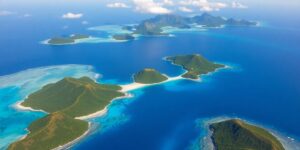Planning a trip to French Polynesia? If you’re dreaming of visiting multiple islands, the Air Tahiti Pass is something you’ll want to know about. It makes hopping between islands easier and can save you money, too. This guide breaks down how to use it, where to go, and what to expect.
Key Takeaways
- The Air Tahiti Pass is a great way to visit multiple islands in French Polynesia without breaking the bank.
- Some must-visit islands include Bora Bora, Moorea, and Tahiti, but don’t skip hidden gems like Maupiti or Tikehau.
- Balance your trip with a mix of adventure and downtime to truly enjoy each island.
- Pack light and be ready for short flights or boat rides between islands.
- Travel during the off-season to avoid crowds and save on costs.
Exploring the Air Tahiti Pass for Multi-Destination Itineraries

Understanding the Benefits of the Air Tahiti Pass
The Air Tahiti Pass is like a golden ticket for anyone dreaming of exploring French Polynesia’s islands. With just one ticket, you can hop between multiple islands, saving both money and the hassle of booking separate flights. This pass is especially great for those who want flexibility—it lets you change travel dates without extra fees. For families, spontaneous adventurers, or anyone looking for a stress-free way to travel, it’s a no-brainer. Plus, it supports eco-friendly travel options, which is always a win.
- Covers multiple islands with one reservation
- No extra fees for changing travel dates
- Budget-friendly for families and groups
How the Air Tahiti Pass Simplifies Island Hopping
Island hopping can be a logistical nightmare if you’re not prepared. The Air Tahiti Pass simplifies everything by consolidating all your flights into one booking. This means less time stressing over schedules and more time enjoying the turquoise lagoons and lush landscapes. The pass also opens up access to hidden gems like secluded beaches and cultural treasures, which might not be on your radar otherwise. It’s like having a personal guide to the best-kept secrets of French Polynesia.
Here’s how it works:
- Choose the pass that fits your travel plans (there are different options based on the number of islands).
- Book your flights in one go—easy and straightforward.
- Enjoy the flexibility to tweak your itinerary as you go.
Eligibility and Requirements for the Air Tahiti Pass
Before you pack your bags, make sure you’re eligible for the pass. It’s available to all international travelers, but you’ll need to meet a few basic requirements:
- Your journey must start and end in Tahiti.
- You’ll need to book a minimum of two islands to qualify.
- Travel dates must fit within the pass’s validity period.
The pass is designed to encourage exploration, so it’s perfect for those who want to experience more than just the main island. Whether you’re visiting for the first time or you’re a seasoned traveler, the Air Tahiti Pass is your ticket to exploring the beauty of Tahiti and beyond.
Top Islands to Include in Your French Polynesia Itinerary
Must-Visit Islands for First-Time Travelers
If you’re heading to French Polynesia for the first time, there are a few islands you just can’t miss. Bora Bora, often called the Jewel of the South Seas, is a dream for anyone seeking turquoise lagoons and luxurious overwater bungalows. Whether you’re snorkeling with vibrant marine life or simply soaking in the views, this island is pure magic. Explore Bora Bora for its stunning landscapes and vibrant underwater world.
Tahiti, the largest island, is your entry point into French Polynesia. Its bustling markets, ancient marae (temples), and the rugged beauty of Tahiti Iti offer a mix of culture and adventure. Don’t forget to try the local delicacy, poisson cru, while you’re here.
Lastly, Moorea, just a short ferry ride from Tahiti, is known for its dramatic mountain peaks and lush greenery. It’s perfect for hiking, diving, or simply relaxing on pristine beaches.
Hidden Gems Beyond the Popular Destinations
For those looking to stray off the beaten path, French Polynesia has plenty of hidden treasures. Fakarava, part of the Tuamotu Archipelago, is a UNESCO Biosphere Reserve and a diver’s paradise. The coral reefs here are teeming with life, making it one of the best spots for underwater exploration.
Then there’s Tikehau, often referred to as the Pink Sand Island. Its secluded beaches and abundant marine life make it perfect for travelers seeking tranquility. Discover Fakarava and Tikehau to uncover these lesser-known gems.
Lastly, the Marquesas Islands offer a completely different vibe. These rugged, remote islands are rich in history and culture, with ancient tiki statues and traditional arts that showcase the Polynesian spirit.
Cultural Highlights of Each Island
Each island in French Polynesia has its own unique story to tell. In Tahiti, you can visit ancient marae and learn about Polynesian mythology. Bora Bora’s cultural festivals, like Heiva i Bora Bora, bring traditional dances and music to life.
The Marquesas are a hub for traditional arts, from wood carving to tattooing, which holds deep cultural significance here. Meanwhile, in Moorea, you can visit vanilla farms and learn about the island’s agricultural traditions.
Whether you’re drawn to the popular spots or intrigued by the hidden corners, French Polynesia offers a mix of adventure, relaxation, and cultural discovery that’s hard to find anywhere else. Balance your itinerary to experience both the well-loved icons and the quieter, lesser-known islands.
Planning Your Multi-Destination Itinerary in French Polynesia

Balancing Adventure and Relaxation
When planning your trip, think about how you want to split your time between exploring and unwinding. French Polynesia has so much to offer, from hiking lush trails to lounging on pristine beaches. A good rule of thumb is to alternate active days with more laid-back ones. For example, you could spend a day snorkeling in Moorea and then follow it with a spa day on Bora Bora. This way, you’ll keep your energy up throughout the trip.
Choosing the Right Duration for Your Trip
The duration of your trip can make or break your experience. A week might be enough for two or three islands, but if you want to see more, consider staying 10-14 days. Here’s a simple breakdown:
| Trip Length | Number of Islands to Visit |
|---|---|
| 5-7 days | 2-3 islands |
| 8-10 days | 3-5 islands |
| 11-14+ days | 5+ islands |
Remember, travel between islands takes time, so don’t overbook yourself. Quality beats quantity when it comes to enjoying each destination.
Tips for Efficient Travel Between Islands
Efficient travel is all about timing and preparation. Here are some quick tips:
- Book flights early: Popular routes can fill up fast, especially during peak seasons.
- Pack light: Inter-island flights have strict baggage limits.
- Plan around flight schedules: Some flights are only available on specific days, so coordinate your itinerary accordingly.
Planning ahead is key to a smooth and stress-free experience. A little extra effort now can save you headaches later.
Navigating Transportation Between Islands
Air Tahiti Flight Schedules and Routes
When it comes to getting around French Polynesia, Air Tahiti is your go-to airline. Their network connects most of the islands, making it relatively easy to hop from one destination to another. Flights are frequent but not always daily, so planning ahead is key. Typically, flights operate on a hub-and-spoke system, with Papeete on the island of Tahiti serving as the central hub. From there, you can catch flights to popular islands like Bora Bora, Moorea, and Raiatea.
Here’s a quick snapshot of some common routes:
| From | To | Approx. Flight Time |
|---|---|---|
| Tahiti | Bora Bora | 50 minutes |
| Tahiti | Moorea | 15 minutes |
| Tahiti | Rangiroa | 1 hour 15 minutes |
Make sure to check the schedules in advance, especially if you’re planning to visit multiple islands in a short time. Many resorts in Tahiti are easily accessible, typically requiring only a short flight or boat ride, adding to the convenience.
Alternatives to Air Travel in French Polynesia
While Air Tahiti is the quickest option, there are other ways to explore the islands. Ferries, for example, are a budget-friendly alternative. The ferry between Tahiti and Moorea is particularly popular, taking only about 30 minutes. For a more adventurous experience, you might consider private boat charters, which offer flexibility and the chance to explore less-visited areas.
Here are a few options to consider:
- Ferries: Great for short distances like Tahiti to Moorea.
- Private Charters: Ideal for exploring remote islands or enjoying a personalized experience.
- Cruise Ships: Some travelers opt for cruises that stop at multiple islands, combining transportation and accommodation.
Packing Tips for Inter-Island Travel
Traveling between islands often involves small planes or ferries, so packing light is a smart move. Most airlines have strict baggage limits, and ferries can get crowded, so you’ll thank yourself for keeping it simple. Focus on versatile clothing, and don’t forget essentials like sunscreen and reusable water bottles.
Here are a few tips to make your travel smoother:
- Use a soft-sided bag or backpack that’s easy to stow.
- Keep important items like passports and tickets in a waterproof pouch.
- Pack light layers to adapt to changing weather conditions.
Traveling between islands is part of the adventure. Whether you’re flying over turquoise lagoons or cruising through calm waters, each journey is an opportunity to soak in the beauty of French Polynesia.
Maximizing Your Experience on Each Island
Top Activities to Try on Each Island
Each island in French Polynesia offers a unique vibe, and exploring them is half the fun. Whether you’re into water sports, hiking, or just soaking in the views, there’s something for everyone. Snorkeling and diving are a must—think vibrant coral reefs and an underwater world you’ll never forget. For example, Raiatea is known for its incredible lagoon tours and cultural sites, making it a top pick for adventurers and history buffs alike. On Huahine, you can paddleboard in serene lagoons or visit ancient marae, blending fun with a touch of history.
Local Cuisine and Dining Recommendations
Food is a huge part of the experience here. You’ll find everything from fresh seafood to tropical fruits that taste like sunshine. Don’t miss out on poisson cru—it’s like ceviche but with a Polynesian twist. On Raiatea, try local dishes at small, family-run eateries—they’re as authentic as it gets. Meanwhile, Huahine is famous for its locally grown vanilla, so grab desserts or even coffee infused with this fragrant ingredient.
Cultural Etiquette and Traditions to Know
Being respectful of local customs is a big deal. When visiting sacred sites, like the marae on Huahine and Raiatea, dress modestly and avoid loud behavior. Polynesians are incredibly warm, and a simple "ia orana" (hello) goes a long way. If you’re networking with locals or even remote workers, like in Tahiti, keep in mind cultural norms and legal requirements, including visas, to make your stay smooth. Tahiti’s community offers a great mix of local and expat vibes, perfect for those looking to connect while exploring.
Budgeting for a Multi-Destination Trip

Cost Breakdown of the Air Tahiti Pass
Planning a multi-destination trip in French Polynesia can seem costly at first, but the Air Tahiti Pass is a game-changer for reducing travel expenses. This pass bundles flights to multiple islands, offering a more economical option than booking individual tickets. Here’s a quick breakdown of what you might expect:
| Pass Type | Approximate Cost (USD) | Islands Covered |
|---|---|---|
| Bora Bora Pass | $400-$500 | Society Islands |
| Marquesas Pass | $600-$800 | Marquesas Islands |
| Combo Pass | $900-$1,200 | Multiple Archipelagos |
Tip: Book your pass early to lock in better rates and ensure availability for your preferred travel dates.
Saving Money on Accommodations and Activities
French Polynesia offers a range of accommodations, from luxury resorts to budget guesthouses. To save money:
- Stay at pensions (family-run guesthouses) for an authentic and affordable experience.
- Look for package deals that combine lodging with activities like snorkeling or cultural tours.
- Travel during the shoulder season (April-May or October-November) for lower rates and fewer crowds.
For activities, consider free or low-cost options such as hiking, beachcombing, or visiting local markets. Many islands also offer inexpensive bike rentals, which are a great way to explore.
Managing Unexpected Expenses
Even with careful planning, unexpected costs can arise. Here’s how to prepare:
- Set aside an emergency fund for things like medical needs or last-minute flight changes.
- Check baggage fees for inter-island flights, as they can add up quickly.
- Carry some local currency (CFP Franc) for small purchases, as credit cards aren’t always accepted in remote areas.
Budgeting for a multi-island trip doesn’t mean sacrificing experiences. With thoughtful planning, you can enjoy the beauty and culture of French Polynesia without breaking the bank.
By keeping these tips in mind, you’ll be able to make the most of your trip while staying within your budget. Whether you’re exploring the convenience of the Air Tahiti Pass or finding ways to save on accommodations, every little effort counts toward an unforgettable adventure.
Best Times to Visit French Polynesia for Island Hopping
Seasonal Weather Patterns and Their Impact
When planning your trip to French Polynesia, the weather is a big deal. The islands have two main seasons: the dry season (May to October) and the wet season (November to April). During the dry months, you can expect sunny skies, cooler temperatures, and less humidity—perfect for exploring islands like Bora Bora or Moorea. The dry season is considered the best time for island hopping, as the weather is more predictable, and outdoor activities like snorkeling or hiking are more enjoyable. On the flip side, the wet season brings warmer temperatures and frequent rain showers, but it also means fewer crowds and lush, green landscapes.
Festivals and Events to Plan Around
French Polynesia is rich in culture, and the islands host vibrant festivals throughout the year. If you visit in July, don’t miss the Heiva i Tahiti festival, a month-long celebration of traditional dance, music, and sports. The wet season also has its share of events, like the Hawaiki Nui Va’a canoe race in November, which draws competitors and spectators from all over the world. Planning your trip around these events can add a unique cultural layer to your itinerary.
Avoiding Crowds During Peak Travel Times
The dry season is peak tourist time, so popular islands like Bora Bora can get crowded, and prices for accommodations and activities may go up. If you prefer a quieter experience, consider visiting during the shoulder months—April or November. These months offer a mix of decent weather and fewer tourists, giving you the best of both worlds. Plus, it’s often easier to snag deals on flights and hotels during these less busy times.
Sustainable Travel Tips for French Polynesia
Eco-Friendly Accommodations and Tours
When visiting French Polynesia, consider staying at eco-lodges or resorts that prioritize sustainability. Many properties use solar energy, recycle waste, and support local communities. Look for certifications like EarthCheck or Green Globe to ensure your stay aligns with eco-friendly practices. Choosing accommodations that respect the environment can make a big difference.
For tours, opt for operators who emphasize low-impact activities. Kayaking, paddleboarding, and snorkeling are great ways to explore without disturbing marine life. Avoid tours that involve feeding wildlife or disrupting coral reefs.
Respecting Local Ecosystems and Wildlife
French Polynesia’s beauty lies in its untouched nature. When snorkeling or diving, avoid touching coral or marine animals—they’re fragile and essential to the ecosystem. Stick to marked trails when hiking to prevent soil erosion and protect native plants.
A few quick tips:
- Use reef-safe sunscreen to protect marine life.
- Dispose of trash properly, especially plastics.
- Avoid single-use plastics by carrying a reusable water bottle and utensils.
Supporting Local Communities Through Tourism
Engage with local artisans, farmers, and businesses to ensure your spending benefits the community. Buying handmade crafts or dining at family-owned restaurants not only enriches your experience but also supports the local economy.
Participate in cultural workshops or events to learn about Polynesian traditions. This not only deepens your connection to the islands but also shows respect for their heritage.
Sustainable travel isn’t just about the environment—it’s about leaving a positive impact on the people and places you visit.
By planning thoughtfully, you can explore French Polynesia responsibly while preserving its natural and cultural treasures for generations to come.
Overcoming Common Challenges in Multi-Destination Itineraries

Dealing with Flight Delays and Cancellations
Flight delays or cancellations can throw a wrench into even the best-laid plans. The key is to stay flexible and prepared. Here are a few tips to manage these hiccups:
- Always check Air Tahiti’s schedule updates a day before your flight.
- Build buffer days into your itinerary, especially if you have tight connections.
- Consider travel insurance that covers delays and cancellations.
If you’re using the Air Tahiti Pass, remember that rescheduling is often possible, but it’s better to confirm availability in advance.
Pro tip: Keep your essentials, like a toothbrush, a change of clothes, and any medications, in your carry-on. This way, you’re prepared for unexpected overnight stays.
Staying Connected While Traveling
Wi-Fi and cellular service can be spotty on some islands. To stay connected:
- Purchase a local SIM card upon arrival in French Polynesia for better coverage.
- Download offline maps and travel apps before your trip.
- Use accommodations that offer Wi-Fi, especially if you’re working remotely or need to stay in touch.
For those staying in overwater bungalows, many offer reliable Wi-Fi, but it’s worth confirming with the property.
Adapting to Different Island Environments
Each island in French Polynesia has its own vibe, climate, and challenges. Packing smartly is essential to adapt:
- Use lightweight, breathable clothing for humid weather.
- Pack reef-safe sunscreen to protect marine life.
- Bring sturdy water shoes for exploring coral reefs and lagoons.
Exploring hidden gems with the Air Tahiti Pass means you’ll encounter diverse terrains, from sandy beaches to volcanic trails. Being prepared ensures a smoother adventure.
Tip: Embrace the laid-back lifestyle of the islands. Things might not always go as planned, but that’s part of the charm of traveling in French Polynesia.
Planning a trip with multiple stops can be tricky, but it doesn’t have to be! To make your journey smoother, think about your travel goals and how much time you want to spend at each place. It’s also smart to check the best ways to get from one spot to another. Don’t forget to pack light and stay flexible, as plans can change. For more tips and help with your travel plans, visit our website and start your adventure today!
Wrapping It Up
So, there you have it. Planning a trip through French Polynesia with the Air Tahiti Pass might seem like a lot at first, but once you get the hang of it, it’s pretty straightforward. You get to hop between islands, explore different vibes, and really make the most of your time there. Sure, it takes a bit of effort to map it all out, but it’s totally worth it when you’re sitting on a beach in Bora Bora or hiking in Moorea. Just take it one step at a time, and don’t stress too much about making it perfect. The islands have a way of making everything feel just right anyway. Happy travels!
Frequently Asked Questions
What is the Air Tahiti Pass and how does it work?
The Air Tahiti Pass is a special ticket that lets you visit multiple islands in French Polynesia. You pay one price and can hop between several islands during your trip.
Who can buy the Air Tahiti Pass?
Anyone can buy the Air Tahiti Pass, but there might be some rules about how and when you can use it. Make sure to check the details before booking.
What are the best islands to visit in French Polynesia?
Some popular islands include Bora Bora, Tahiti, and Moorea. For hidden gems, you might want to check out Tikehau or Maupiti.
How do I plan my trip between the islands?
Start by deciding how many days you want to spend on each island. Then, check the flight schedules to make sure everything fits your plan.
What should I pack for island hopping?
Pack light! Bring comfortable clothes, swimwear, sunscreen, and some snacks. A small carry-on bag is usually enough.
When is the best time to visit French Polynesia?
The dry season, from May to October, is the best time to visit. The weather is sunny, and there’s less rain.
Are there eco-friendly travel options in French Polynesia?
Yes, many hotels and tours focus on protecting the environment. You can also help by respecting nature and avoiding single-use plastics.
What should I do if my flight gets delayed?
Stay calm and check with the airline for updates. Have a backup plan, like extra time in your schedule, just in case.




